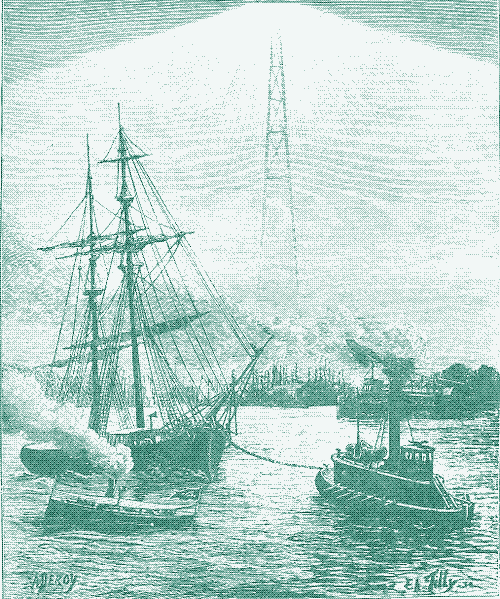
The arc lamp - the first electric light and the predecessor of Edison’s incandescent light bulb - was extremely bright and much more energy efficient than other lighting technologies from those times. The lamps were too strong for indoor use, but they were regarded as the future of municipal lighting. Especially in the United States, many cities and towns were illuminated as if they were immense sports stadiums.
The arc light (or “electric candle”) was invented and demonstrated by Sir Humphry Davy at the very beginning of the 19th century in England. Davy, who can be considered the true founder of electric lighting, discovered that a blinding white light was produced by hooking up two charcoal rods to a battery, and bringing them very close together.
In an incandescent light bulb (which was developed only 70 years later) an electric current is transferred over a filament, but in the case of an arc lamp this happens through the air instead. If two electrified carbon rods touch each other, some of the carbon vaporizes. By further moving the rods just a little bit apart, the current flows through the vaporizing carbon and spans the air gap with an “arc” of intense light.
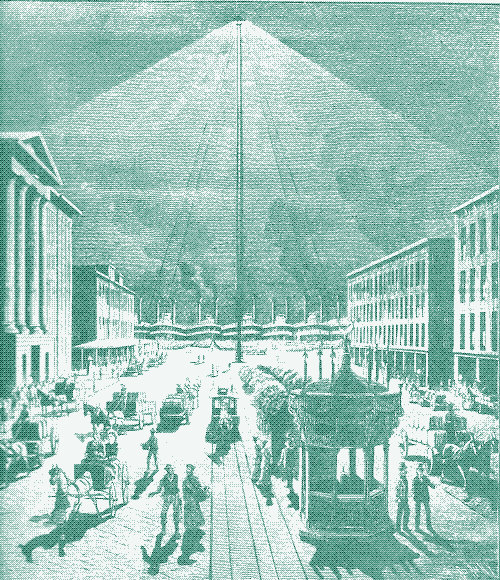
An electric candle typically produced a light of 1,500 to 6,000 candlepower, which corresponds to the output of 11 to 43 modern 100-watt incandescent light bulbs. The temperature in the arc could rise to 4,000 degrees Celsius (more than 7,000 degrees Fahrenheit), the highest temperature that man achieved until the arrival of the atomic bomb.
Candles, oil and gas lamps
The discovery of the arc light was a spectacular feat, because the light it produced was incomparably stronger than anything else available at that time: candles, oil lamps and – appearing around the same time – open flame gas lights, which produced only 10 to 20 candlepower.
It was obvious that the powerful light of an arc lamp was absolutely unsuitable for use in a room. As a way of lighting up streets and large interior spaces, however, the technology sounded very promising.
Large buildings, like theatres, were sometimes lit by hundreds or even thousands of candles. It took an awful lot of work to install, to light and to replace all those candles (see below), not to mention the toxic smoke, the smell, the heat, the built-up of soot and the risk of fire resulting from this.
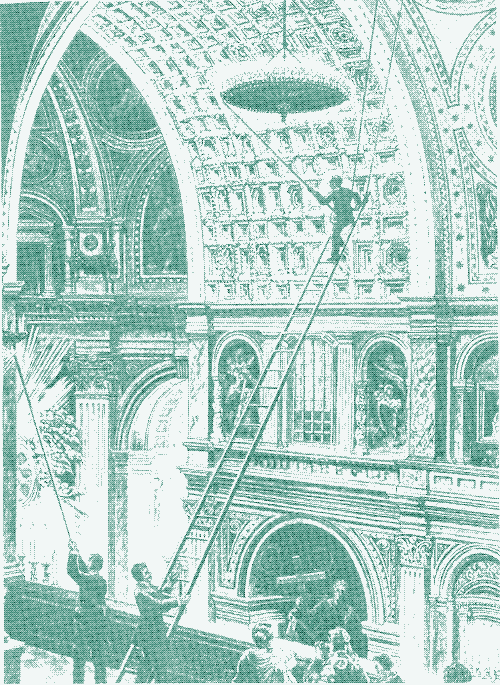
Oil lamps had similar drawbacks, and the recent open flame gas lamps were only a modest improvement - the only advantages being that they were a little bit stronger and cleaner and only had to be ignited once. Streets were lit by oil or open flame gas lamps (or not at all). Every street lamp had to be lit individually every night, and extinguished every morning.
Lamps, but no electricity
In spite of the poor alternatives, it took more than 70 years before the arc lamp resulted in practical lighting devices on a large scale. The problem was not so much the lamp itself, but the power source. The only sources of electricity during the first half of the 19th century were inefficient batteries, which made the use of arc lamps very impractical and excessively expensive.
In the 1840s and 1850s, there were some public demonstrations with arc lights and a few early limited applications (notably in lighthouses, theatres and on large construction sites), but it was only with the arrival of useful electric generators (dynamos) at the end of the 1870s, that the arc lamp took off.
Around that time, the most important disadvantage of the arc lamp was also solved. The carbon rods were consumed while the lamp was burning, which meant that the lamp had to be regulated by hand almost continuously to keep the distance between the rods constant.
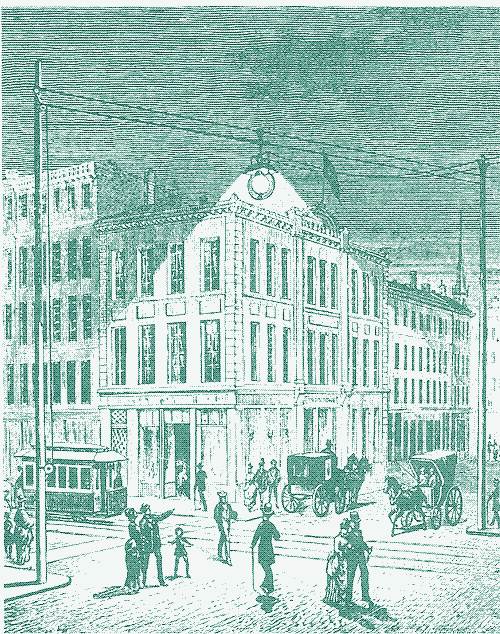
This was more or less resolved in the 1840s by self-regulating mechanisms (illustration at right), but it was the invention of the Yablochkov arc lamp in 1876 that resolved the issue completely. The rods were placed parallel to each other, which eliminated the need for complex mechanisms. That made the arc lamp much more reliable.
Twenty times more energy efficient
At the end of the 1870s, gas light had conquered the streets of many cities, to a lesser degree still supported by earlier oil lamps. But arc lamps were brighter, cheaper and safer. Around the same period the first practical incandescent light bulbs appeared, but they were not much competition either.
Early incandescents only produced around 12 candlepower and were 20 times less energy efficient than arc lamps (it is interesting to note that 19th century arc lamps are still more energy efficient than todays incandescents, and that early 20th century arc lamps can even compete with today’s compact fluorescents – but this is comparing apples with oranges since arc lights were not suited for use indoors).
What followed was a true boom of arc lighting. Hundreds of thousands of arc lights were installed, mainly on streets and squares but also on markets, in harbours, railway stations, public buildings, department stores, exhibition halls, hotels, theatres, office buildings, castles, monuments, museums and libraries.
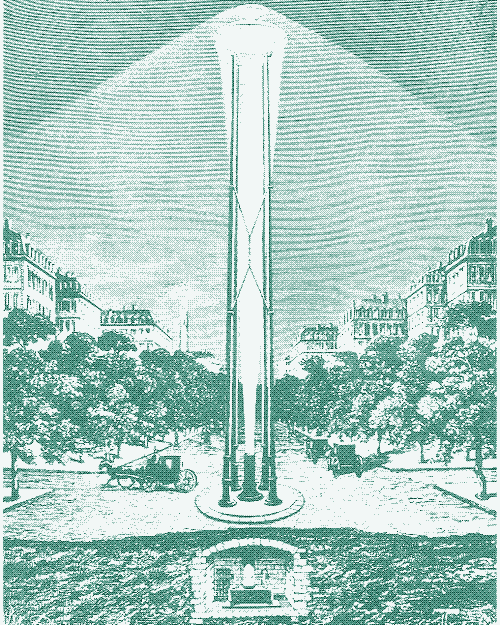
Paris set the ball running in 1877, with 54 street lights on the Avenue de l’Opéra and 80 lamps in the Grand Magasins du Louvre. London and other European cities followed in 1878, and in 1879 the first arc lights were installed in the United States.
The US quickly became the leader of electric arc lighting. In 1884 there were already more than 90,000 arc lamps lighting the night sky in the US, and that number rose to 235,000 in 1890, when virtually every US city was using arc lighting, more than 400,000 in 1902 and almost 700,000 in 1907. But it was not just in numbers that the US outstripped Europe and Great Britain.
Moonlight towers
While European cities placed electric candles on posts, like we do today with street lights, the Americans had the idea of lighting entire cities and villages by means of a grid of towers that stood up to 300 feet (90 metres) tall.
These structures, sometimes resembling oversized oil derricks, were equipped with 4 to 6 arc lights of 2,000 to 6,000 candle power each. Most of them burnt all night and all year (except at full moon) although some cities turned the lights off around midnight.
The first arc light tower was erected in San José, California, in December 1881 (above). It stood 237 feet tall and was supplied with 6 arc lights boasting a total light production of 24,000 candlepower (a replica half the height has been built on the same spot, the original tower collapsed in 1915 following a storm).
Eiffel tower
The idea of placing arc lights on towers did not go unnoticed in Europe. It is believed that the Eiffel Tower in Paris, finished in 1889 and also equipped with powerful arc lights (below), was inspired by the first San José tower - the American city even sued Paris (in 1989!), unsuccessfully.
During the 1880s and 1890s, dozens of American cities built an infrastructure of arc light towers on their territory. Placing arc lights on high towers made sense. One of the main disadvantages of electric candles was their labour-intensive operation. The carbon rods had to be replaced every one or two hours. That would make arc lights as cumbersome as candles, gas lights or oil lamps, were it not for the fact that they were so much brighter.
Arc light kills a smoker
By grouping them on towers, this carbon trimming could be done with much less man power than was needed for other systems (including arc lights placed on poles or hung at intersections). Moonlight towers were also the most energy efficient way of lighting a whole city, because a minimal amount of lamps was needed, so that everything taken together the lighting tower system was the cheapest available method to light a complete city.
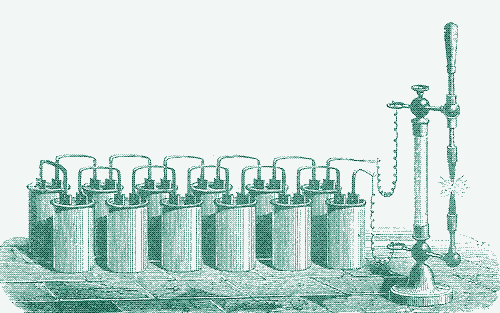
The tower system also had the advantage of safety. Witness this report from the New York Times, Arc light kills a smoker (1907):
“Joseph Gooden was instantly killed by an electric shock today while he was attempting to light a cigar from an arc lamp in the street. With several companions he was returning from a dance when, in a spirit of bravado, he lowered one of the big electric street lamps and put his cigar against one of the carbons. He received a shock of 2,000 volts.”
Detroit as a shining example
In most American cities the lighting tower infrastructure was combined with arc lamps placed on poles or hung at intersections, and complemented with gas or and oil lamps, or incandescents. Detroit was the only large city in the US (and in the world) lighted wholly and exclusively by the tower system.
Detroit placed 122 towers with a height of 100 to 180 feet, lighting 21 square miles of the city. All towers were installed in the 1880s and remained in use up to the end of the 1910s. The lighting infrastructure in Detroit was regarded as the future of street lighting, and stood as an example for the rest of the US. The following excerpts are taken from “Municipal lighting”, a practical guide for city lighting that was published in 1888:
“The press of the country has uniformly conceded* Detroit *to be the best-lighted city in the world. All its streets, yards, backyards and grounds are illuminated as effectually as by the full moon at the zenith. The blending of light from the mass of towers serves to prevent dense shadows.”*Detroit has about 230,000 inhabitants, and has a dense business section of about one square mile. This section has about 20 towers, which average 1,000 to 1,200 feet apart. The belt immediately contiguous, embracing the closely-built and densely shaded residence section has its towers about 2,000 feet apart. Beyond this the spaces widen to 2,500 feet apart, and in the suburbs they are spaced about 2,500 to 3,000 feet apart."
Towers: the best buy
“The last gas estimate for the 7.5 square miles lighted was 104,300 dollars. The amount paid the past year for lighting 21 square miles by the tower system was about 112,000 dollar. The tower lights are burned from dusk to daylight every night in the year. The same service from 2,600 pole lights would amount to 332,150 dollar per year."
“Lighting by the tower system is assuming great prominence, and merits the calm and thoughtful consideration of all interested in the subject of public lighting. It is the only system thus far presented which affords a thoroughly practical illumination of all spaces at a figure below the cost of gas or naphtha, as the latter is usually employed for quite inadequately lighting the streets alone.”
Guidelines
The success in Detroit led to a detailed set of guidelines, to be followed by other American cities. How many towers are needed? The book explains in detail:
“Towns of 3,000 to 6,000 inhabitants, occupying, say, a square mile of space, may be lighted in every quarter by 7 towers, one at the center and six at the angles of a hexagon, the towers being 2,000 feet apart. So, also, illumination may be had by five towers, there being one at the center and four at the angles of a square, the towers being 2,000 feet from the middle tower, and where greater economy is desirable there might be four towers, one at the center and one at each of the angles of a triangle and about 2,000 feet from the center tower. From 100,000 to 200,000 inhabitants: 100 to 150 towers.More than 200,000 inhabitants: 150 to 300 towers. The towers should, as far as practicable, be arranged in a triangular system. In all cases it is recommended that the towers should have at least four lights of 2,000 candlepower each. The central towers might have six lights.”
Dark corners
The guidebook acknowledges that towers are in many cases best complemented by other arc lights, preferably placed at intersections:
“It will rarely happen that the tower system can be used exclusively in any place. There will always be dark corners that cannot be reached except at great expense, and in such localities a single low light is used with good effect.”
“Placing lamps over the intersection of streets is the best method when low arc lighting is desired. By placing a lamp over the intersection of a street, you place the lamp where it can do the most possible good, as it can light the streets equally in four directions a distance of about 400 feet radius of the lamp.”
Disadvantages of the tower system
Not everybody was convinced of the tower system, however. In one chapter of the book, local authorities are asked for their experiences with the moonlight towers. As well as many positive (and sometimes ecstatic) comments, some responses were very negative. In Ogden, Utah, for instance:
“The tower system of electric lighting was tried here several years ago, and discarded as being a complete failure. It is a bad system for street lighting, being impossible to erect a tower high enough to throw the lights in the streets uniformly. One side of the streets will be shaded by the buildings, which produces an intense darkness (when contrasted by the light on the opposite side), which is very disagreeable. Our city is now lighted by electric lamps placed in the center of the street.”
Others had a more balanced opinion. Council Bluffs, Iowa:
“The light is certainly an improvement on the gas lamps. The light is about the same that would be expected from a half moon. You can notice the removal of a brick, stone or plank on the sidewalk, as you walk along. Still, there are people who complain that the light is not sufficiently bright.”
Saginaw, Michigan:
“I should never use towers in thickly settled parts, where streets are all built up on both sides with high buildings: even three story buildings appear to destroy the effect of light sideways. Towers do well in wide streets, and will range 1,500 to 2,000 feet each side.”
Utica, New York:
“The towers are used mainly in the outskirts and thinly settled districts. There they are a perfect success. In the heart of the city they are a failure.”
The decline of moonlight towers
The criticism of some local authorities in 1888 already showed what would eventually be the death-sentence of the lighting tower system: the arrival of ever higher buildings. The first decades of the 20th century were the era of the skyscraper, and those buildings were incompatible with moonlight towers. Lighting towers that were higher than 150 feet, like the first one in San José, proved ineffective. From the guidebook:
“The advantages of the tower system are only realized when the lamps are placed high enough above the trees and buildings, that they may radiate their light without obstructions near the lamps. The lamps should not be at so great an elevation as that their light will be dissipated in the air before reaching the ground. In the matter of proper height, 150 feet is the most satisfactory. Increasing the height impairs the illumination near the foot and does not perceptibly increase the total lighted area, while diminishing its height diminishes the illuminated area and affords unnecessary brilliance at the base.”
Life expectancy
Improvements in arc lamp design were another reason for the decline of the tower system. In the 1890s the carbon consumption of the rods was slowed down considerably by enclosing the lamp in a gas tube, which increased the life expectancy of the carbon sticks fivefold – enough to make the rods last all night.
That made it possible to maintain arc lights in streets and on intersections with more or less the same amount of man power than what was needed for the towers. More lamps were required in that case, which made the system slightly more expensive, but the distribution of light was much better.
Later arc lights could burn for 100 to 150 hours (4 to 6 days) without replacing the rods. Also, the irritating sound production of arc light, another disadvantage of low arc lighting, was largely solved in the 1890s.
Incandescents & LEDs
Another reason for the decline of the moonlight towers was the fact that alternative electric systems, notably the incandescents of Edison, were improved substantially. Again, the advantage was a better distribution of light, which justified slightly higher costs. This was already acknowledged in 1888:
“The advantage of the greater candle power of the arc light is offset by the much better distribution of the incandescent, so that all things considered the incandescent is not at such disadvantage as would appear from the mere comparison of the candle power of the different lights”.
The merit of Edison was that he succeeded in dividing the intense light of the arc lamp in smaller units, so that electric lighting eventually became suited for use inside buildings, even in small rooms. The current development of LED-lights faces the opposite challenge as that of early electric lighting: to create a bright white light that is strong enough to compete with incandescents and fluorescents.
Film projectors and search lights
Most lighting towers were demolished during the first two decades of the 20th century (quite a few also collapsed during storms and tornados, or were destroyed by bus drivers misjudging a turn). The only ones that remain today are 17 (of originally 31) towers in Austin, Texas – they are still working, albeit not by means of arc lights. Lighting towers are still used today, of course, during events and on traffic junctions and construction sites for instance, but they too make use of more advanced lamps.
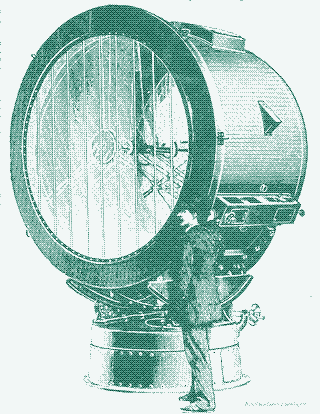
Arc lights lasted longer than arc light towers – in London they were still found on the streets in the 1950s. They also found new applications, notably as film projectors and searchlights. Carbon arc searchlights arrived on the market in 1915 and thousands of them - much more powerful than those used for city lighting - were applied in World War II during military operations. In the 1920s, arc lights were marketed as family health products as a substitute for sunlight.
Compact Fluorescents
Even today, the technology still lives on in a more sophisticated form. Most street lamps and followspots in use today, and even fluorescent compact bulbs and neon lights, are descendants of the electric candle. Another important technology that has developed out of arc lighting, is welding. This explains why it is not advised to build an arc light yourself (which is a fairly easy thing to do) because staring at the arc from nearby can damage your eyes.
More information and illustrations:
- De Bliksem Getemd, Leonard De Vries, 1979
- Municipal Lighting, Fred H. Whipple, 1888
- The New York Times article archive - Exhibiting Electricity
{width=“1” height=“1”}, K.G. Beauchamp, 1997
- Explaining the collapse of the British electrical supply industry, Business and Economic History, fall 1993
- Moonlight tower, Wikipedia - Electric Universe: The Shocking True Story of Electricity, David Bodanis, 2005
Reactions
To make a comment, please send an e-mail to solar (at) lowtechmagazine (dot) com. Your e-mail address is not used for other purposes, and will be deleted after the comment is published. If you don’t want your real name to be published, sign the e-mail with the name you want to appear.
Reactions
Hoot
What a great website! Such interesting articles - this one, especially.
M
Low-tech Magazine is the only magazine worth subscribing to, offering up, as it does, such in-depth, erudite, and fascinating articles. Thank you.
David Le Page
This lighting arrangement is still used in many South African townships and informal settlements, where the light easily drops amidst the low buildings. It may be practical, but it brings something of a Big Brother quality to what it illuminates.
Denis
The half-height replica of the San Jose Electric Tower was not built on the same spot as the original. It’s at the history park a few miles away.
Mike
Here’s a link to Bing Maps showing the locations of many of the towers in Detroit, including pictures.
http://www.bing.com/maps/?v=2&cp=42.34459769428406~-83.03744895880845&lvl=13&sty=r&cid=B43DED777F9D2CC6!114
Bill Thon
there was a segment on Edison today (2-25-13) on Diane Rehm. they mentioned arc lighting on towers in the 1880s I did not know this type of lighting on towers existed..here I am on your site learning something!!!! Thanks Bill Thon
Slowburn
I would have thought tall buildings would have been a boon to them by providing towers to hang them on.
Arc Light Museum/Szirmai Gábor leader
Thank for the article!! For our Museum (under construction now) in Hungary is a good information this. We waiting the visitor free - name our museum the follow: “Arc light Museum-Budakeszi”(in hungarian: Ívfény Múseum-Budakeszi") See the Google this hungarian title! We shall to walk with You free around the Museum, and we shell give to You explain/performance - but our english is poor (You see!)We have books (the library is free),pictures,objects. Our Museum is very poor (the goverment give us 90 USD/mounth, but You need not to pay.We wait for You!